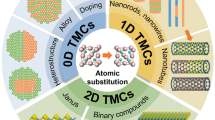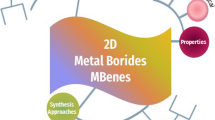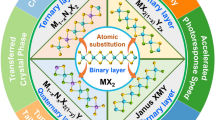Abstract
The electronic structures of \(\hbox {Hf}_{1-x}\hbox {Zr}_{x}\hbox {S}_{3}\) and \(\hbox {Hf}_{1-x}\hbox {Zr}_{x}\hbox {Se}_{3}\) trichalcogenides are investigated by first-principles calculation. In particular, step change of Zr concentration is intensively investigated. Our calculations reveal that doping of Zr atoms increase the strength of cohesion between the atoms in \(\hbox {HfX}_ 3\) (X = S, Se) monolayers, and results in occurring of energetically more stable alloys. In addition, doping of Zr atoms in \(\hbox {HfS}_3\) causes band gap bowing, which means the curve of band gap values shows quadratic nonlinearities while change from semimetal to semiconductor is observed in \(\hbox {HfSe}_3\) case. The examined band structures indicate that \(\hbox {Hf}_{1-x}\hbox {Zr}_{x}\hbox {S}_{3}\) monolayers have very suitable band gap values for water splitting and also their band edge potentials have sufficiently higher or lower positions than the required potential values for the reduction or oxidation potentials.






Similar content being viewed by others
References
Lv R, Robinson JA, Schaak RE, Sun D, Sun Y, Mallouk TE, Terrones M (2014) Transition metal dichalcogenides and beyond: synthesis, properties, and applications of single-and few-layer nanosheets. Acc Chem Res 48:56
Liu G-B, Xiao D, Yao Y, Xu X, Yao W (2015) Electronic structures and theoretical modelling of two-dimensional group-VIB transition metal dichalcogenides. Chem Soc Rev 44:2643
Bhimanapati GR, Lin Z, Meunier V, Jung Y, Cha J, Das S, Xiao D, Son Y, Strano MS, Cooper VR (2015) Recent advances in two-dimensional materials beyond graphene. ACS Nano 9:11509
Manzeli S, Ovchinnikov D, Pasquier D, Yazyev OV, Kis A (2017) 2D transition metal dichalcogenides. Nat Rev Mater 2:17033
Balendhran S, Walia S, Nili H, Sriram S, Bhaskaran M (2015) Elemental analogues of graphene: silicene, germanene, stanene, and phosphorene. Small 11:640
Aktürk E, Aktürk O, Ciraci S (2016) Single and bilayer bismuthene: stability at high temperature and mechanical and electronic properties. Phys Rev B 94:014115
Pumera M, Sofer Z (2017) 2D monoelemental arsenene, antimonene, and bismuthene: beyond black phosphorus. Adv Mater 29:1605299
Zhang S, Guo S, Chen Z, Wang Y, Gao H, Gómez- Herrero J, Ares P, Zamora F, Zhu Z, Zeng H (2018) Recent progress in 2D group-VA semiconductors: from theory to experiment. Chem Soc Rev 47:982
Jariwala D, Sangwan VK, Lauhon LJ, Marks TJ, Hersam MC (2014) Emerging device applications for semiconducting two-dimensional transition metal dichalcogenides. ACS Nano 8:1102
Gupta A, Sakthivel T, Seal S (2015) Recent development in 2D materials beyond graphene. Prog Mater Sci 73:44
Singh D, Gupta SK, Sonvane Y, Lukačević I (2016) Antimonene: a monolayer material for ultraviolet optical nanodevices. J Mater Chem C 4:6386
Tan C, Cao X, Wu X-J, He Q, Yang J, Zhang X, Chen J, Zhao W, Han S, Nam G-H (2017) Recent advances in ultrathin two-dimensional nanomaterials. Chem Rev 117:6225
Yorulmaz U, Ozden A, Perkgoz NK, Ay F, Sevik C (2016) Vibrational and mechanical properties of single layer MXene structures: a first-principles investigation. Nanotechnology 27:335702
Yan C, Gong C, Wangyang P, Chu J, Hu K, Li C, Wang X, Du X, Zhai T, Li Y, Xiong J (2018) 2D group IVB transition metal dichalcogenides. Adv Funct Mater 28:1803305
Zeng Q, Liu Z (2018) Novel optoelectronic devices: transition-metal-dichalcogenide-based 2D heterostructures. Adv Electron Mater 4:1700335
Zhang X, Zhang Z, Zhou Z (2018) MXene-based materials for electrochemical energy storage. J Energy Chem 27:73–85
Johari P, Shenoy VB (2012) Tuning the electronic properties of semiconducting transition metal dichalcogenides by applying mechanical strains. ACS Nano 6:5449
Dolui K, Pemmaraju CD, Sanvito S (2012) Electric field effects on armchair \(\text{MoS}_{2}\) nanoribbons. ACS Nano 6:4823
Gong C, Zhang H, Wang W, Colombo L, Wallace RM, Cho K (2013) Band alignment of two-dimensional transition metal dichalcogenides: application in tunnel field effect transistors. Appl Phys Let 103:053513
Shen T, Penumatcha AV, Appenzeller J (2016) Strain engineering for transition metal dichalcogenides based field effect transistors. ACS Nano 10:4712
Kang M, Kim B, Ryu SH, Jung SW, Kim J, Moreschini L, Jozwiak C, Rotenberg E, Bostwick A, Kim KS (2017) Universal mechanism of band-gap engineering in transition-metal dichalcogenides. Nano Lett 17:1610
Tongay S, Narang DS, Kang J, Fan W, Ko C, Luce AV, Wang KX, Suh J, Patel K, Pathak V (2014) Two-dimensional semiconductor alloys: monolayer \(\text{Mo}_{1-x}\text{W}_x\text{Se}_2\). Appl Phys Let 104:012101
Wang Z, Liu P, Ito Y, Ning S, Tan Y, Fujita T, Hirata A, Chen M (2016) Chemical vapor deposition of monolayer \(\text{Mo}_{1-x}\text{W}_x\text{S}_2\) crystals with tunable band gaps. Sci Rep 6:21536
Huang J, Wang W, Fu Q, Yang L, Zhang K, Zhang J, Xiang B (2016) Stable electrical performance observed in large-scale monolayer \(\text{WSe}_{2(1-x)}\text{S}_{2x}\) with tunable band gap. Nanotechnology 27:13LT01
Zhao Y, Zhang Z, Ouyang G (2018) Band shift of 2D transition-metal dichalcogenide alloys: size and composition effects. Appl Phys A 124:292
Dong J, Zhao Y, Ouyang G (2019) The effect of alloying on the band engineering of two-dimensional transition metal dichalcogenides. Physica E 105:90–96
Feng Q, Zhu Y, Hong J, Zhang M, Duan W, Mao N, Wu J, Xu H, Dong F, Lin F (2014) Growth of large-area 2D \(\text{MoS}_{2(1-x)}\text{Se}_{2x}\) semiconductor alloys. Adv Mater 26:2648
Li H, Duan X, Wu X, Zhuang X, Zhou H, Zhang Q, Zhu X, Hu W, Ren P, Guo P (2014) Growth of alloy \(\text{MoS}_{2x}\text{Se}_{2(1-x)}\) nanosheets with fully tunable chemical compositions and optical properties. J Am Chem Soc 136:3756
Ersan F, Gokoglu G, Akturk E (2015) Adsorption and diffusion of lithium on monolayer transition metal dichalcogenides (\(\text{MoS}_{2(1-x)}\text{Se}_{2x}\)) alloys. J Phys Chem C 119:28648
Chen Y, Dumcenco DO, Zhu Y, Zhang X, Mao N, Feng Q, Zhang M, Zhang J, Tan P-H, Huang Y-S (2014) Composition-dependent Raman modes of \(\text{Mo}_{1-x}\text{W}_x\text{S}_2\) monolayer alloys. Nanoscale 6:2833
Gan L-Y, Zhang Q, Zhao Y-J, Cheng Y, Schwingenschlögl U (2014) Order-disorder phase transitions in the two-dimensional semiconducting transition metal dichalcogenide alloys \(\text{Mo}_{1-x}\text{W}_{x}\text{X}_{2}\) (X= S, Se, and Te). Sci Rep 4:6691
Zhang M, Wu J, Zhu Y, Dumcenco DO, Hong J, Mao N, Deng S, Chen Y, Yang Y, Jin C (2014) Two-dimensional molybdenum tungsten diselenide alloys: photoluminescence, Raman scattering, and electrical transport. ACS Nano 8:7130
Perumal P, Ulaganathan RK, Sankar R, Liao Y-M, Sun T-M, Chu M-W, Chou FC, Chen Y-T, Shih M-H, Chen Y-F (2016) Ultra-thin layered ternary single crystals [Sn (\(\text{S}_{x}\text{Se}_{1-x}\)) 2] with bandgap engineering for high performance phototransistors on versatile substrates. Adv Funct Mater 26:3630
Jin Y, Li X, Yang J (2015) Single layer of \(\text{MX}_3\) (M= Ti, Zr; X= S, Se, Te): a new platform for nano-electronics and optics. Phys Chem Chem Phys 17:18665
Dai J, Zeng XC (2015) Titanium trisulfide monolayer: theoretical prediction of a new direct-gap semiconductor with high and anisotropic carrier mobility. Angew Chem 54:7572
Island JO, Biele R, Barawi M, Clamagirand JM, Ares JR, Sánchez C, Van Der Zant HS, Ferrer IJ, D’Agosta R, Castellanos-Gomez A (2016) Titanium trisulfide (\(\text{TiS}_3\)): a 2D semiconductor with quasi-1D optical and electronic properties. Sci Rep 6:22214
Pant A, Torun E, Chen B, Bhat S, Fan X, Wu K, Wright DP, Peeters FM, Soignard E, Sahin H (2016) Strong dichroic emission in the pseudo one dimensional material \(\text{ZrS}_{3}\). Nanoscale 8:16259
Dai J, Li M, Zeng XC (2016) Group IVB transition metal trichalcogenides: a new class of 2D layered materials beyond graphene. Wiley Interdiscip Rev 6:211
Island JO, Molina-Mendoza AJ, Barawi M, Biele R, Flores E, Clamagirand JM, Ares JR, Sánchez C, van der Zant HS, D’Agosta R (2017) Electronics and optoelectronics of quasi-1D layered transition metal trichalcogenides. 2D Materials 4:022003
Kong W, Bacaksiz C, Chen B, Wu K, Blei M, Fan X, Shen Y, Sahin H, Wright D, Narang DS (2017) Angle resolved vibrational properties of anisotropic transition metal trichalcogenide nanosheets. Nanoscale 9:4175
Zhao Q, Guo Y, Zhou Y, Yao Z, Ren Z, Bai J, Xu X (2018) Band alignments and heterostructures of monolayer transition metal trichalcogenides \(\text{MX}3\) (M= Zr, Hf; X= S, Se) and dichalcogenides \(\text{MX}_2\) (M= Tc, Re; X= S, Se) for solar applications. Nanoscale 10:3547
Island JO, Barawi M, Biele R, Almazán A, Clamagirand JM, Ares JR, Sánchez C, van der Zant HS, Álvarez JV, D’Agosta R (2015) \(\text{TiS}_3\) transistors with tailored morphology and electrical properties. Adv Mater 27:2595
Lipatov A, Wilson PM, Shekhirev M, Teeter JD, Netusil R, Sinitskii A (2015) Few-layered titanium trisulfide (\(\text{TiS}_3\)) field-effect transistors. Nanoscale 7:12291
Xie J, Wang R, Bao J, Zhang X, Zhang H, Li S, Xie Y (2014) Zirconium trisulfide ultrathin nanosheets as efficient catalysts for water oxidation in both alkaline and neutral solutions. Inorg Chem Front 1:751
Osada K, Bae S, Tanaka M, Raebiger H, Shudo K, Suzuki T (2016) Phonon properties of few-layer crystals of quasi-one-dimensional \(\text{ZrS}_{3}\) and \(\text{ZrSe}_{3}\). J Phys Chem C 120:4653
Arsentev MY, Petrov A, Missyul A, Hammouri M (2018) Exfoliation, point defects and hydrogen storage properties of monolayer \(\text{TiS}_3\): an ab initio study. RSC Adv 8:26169
Morozova NV, Korobeinikov IV, Kurochka KV, Titov AN, Ovsyannikov SV (2018) Thermoelectric properties of compressed titanium and zirconium trichalcogenides. J Phys Chemi C 122:14362. https://doi.org/10.1021/acs.jpcc.8b03716
Zhou Z, Liu H, Fan D, Cao G, Sheng C (2018) High thermoelectric performance originating from the grooved bands in the ZrSe3 monolayer. ACS Appl Mater Interfaces 10:37031. https://doi.org/10.1021/acsami.8b12843
Flores E, Ares JR, Ferrer IJ, Sánchez C (2016) Synthesis and characterization of a family of layered trichalcogenides for assisted hydrogen photogeneration. Physica Status Solidi Rapid Res Lett 10:802
Aierken Y, Çakır D, Peeters FM (2016) Strain enhancement of acoustic phonon limited mobility in monolayer \(\text{TiS}_3\). Phys Chem Chem Phys 18:14434
Silva-Guillén J, Canadell E, Ordejón P, Guinea F, Roldán R (2017) Anisotropic features in the electronic structure of the two-dimensional transition metal trichalcogenide \(\text{TiS}_3\): electron doping and plasmons. 2D Materials 4:025085
Biele R, Flores E, Ares JR, Sanchez C, Ferrer IJ, Rubio-Bollinger G, Castellanos-Gomez A, D’Agosta R (2018) Strain-induced band gap engineering in layered \(\text{TiS}_3\). Nano Res 11:225
Flores E, Ares J, Sánchez C, Ferrer I (2019) Ternary transition titanium-niobium trisulfide as photoanode for assisted water splitting. Catal Today 107:321–322
Ersan F, Ozaydin H, Aktürk E (2018) Influence of chalcogen composition on the structural transition and on the electronic and optical properties of the monolayer titanium trichalcogenide ordered alloys. Phys Chem Chem Phys 20:1431
Agarwal A, Qin Y, Chen B, Blei M, Wu K, Liu L, Shen Y, Wright D, Green MD, Zhuang H, Tongay S (2018) Anomalous isoelectronic chalcogen rejection in 2D anisotropic vdW \(\text{TiS}_{3(1-x)}\text{Se}_{3x}\) trichalcogenides. Nanoscale 10:15654–15660
Clementi E, Raimondi DL (1963) Atomic screening constants from SCF functions. J Chem Phys 38:2686. https://doi.org/10.1063/1.1733573
Mortensen JJ, Hansen LB, Jacobsen KW (2005) Real-space grid implementation of the projector augmented wave method. Phys Rev B 71:035109
Castelli IE, Olsen T, Datta S, Landis DD, Dahl S, Thygesen KS, Jacobsen KW (2012) Computational screening of perovskite metal oxides for optimal solar light capture. Energy Environ Sci 5:5814
Baerends E (2017) From the Kohn–Sham band gap to the fundamental gap in solids. An integer electron approach. Phys Chem Chem Phys 19:15639
Perdew JP, Burke K, Ernzerhof M (1996) Generalized gradient approximation made simple. Phys Rev Lett 77:3865
Monkhorst HJ, Pack JD (1976) Special points for Brillouin-zone integrations. Phys Rev B 13:5188
Kuisma M, Ojanen J, Enkovaara J, Rantala TT (2010) Kohn–Sham potential with discontinuity for band gap materials. Phys Rev B 82:115106
Xu Y, Yamazaki M, Villars P (2011) Inorganic materials database for exploring the nature of material. Jpn J Appl Phys 50:11RH02
Kresse G, Hafner J (1993) Ab initio molecular dynamics for liquid metals. Phys Rev B 47:558
Kresse G, Furthmüller J (1996) Efficient iterative schemes for Ab initio total-energy calculations using a plane-wave basis set. Phys Rev B 54:11169
Heyd J, Scuseria GE, Ernzerhof M (2003) Hybrid functionals based on a screened Coulomb potential. J Chem Phys 118:8207
Abdulsalam M, Joubert DP (2015) Structural and electronic properties of MX 3 (M= Ti, Zr and Hf; X= S, Se, Te) from first principles calculations. Eur Phys J B 88:177
Saeed Y, Kachmar A, Carignano MA (2017) First-principles study of the transport properties in bulk and monolayer \(\text{MX}_3\) (M= Ti, Zr, Hf and X= S, Se) compounds. J Phys Chem C 121:1399
Bernard JE, Zunger A (1986) Optical bowing in zinc chalcogenide semiconductor alloys. Phys Rev B 34:5992
Li M, Dai J, Zeng XC (2015) Tuning the electronic properties of transition-metal trichalcogenides via tensile strain. Nanoscale 7:15385
Kadioglu Y, Santana JA, Özaydin HD, Ersan F, Aktürk O, Aktürk E, Reboredo FA (2018) Diffusion quantum Monte Carlo and density functional calculations of the structural stability of bilayer arsenene. J Chem Phys 148:214706
Tran F, Ehsan S, Blaha P (2018) Assessment of the GLLB-SC potential for solid-state properties and attempts for improvement. Phys Rev Mater 2:023802
Toroker MC, Kanan DK, Alidoust N, Isseroff LY, Liao P, Carter EA (2011) First principles scheme to evaluate band edge positions in potential transition metal oxide photocatalysts and photoelectrodes. Phys Chem Chem Phys 13:16644
Acknowledgements
This study was partly funded by Materials research by Information Integration Initiative (\(\hbox {MI}^2\hbox {I}\)) project of the Support Program for Starting Up Innovation Hub from Japan Science and Technology Agency (JST), and JSPS KAKENHI Grant-in-Aid for Young Scientists (B) Grant Number JP17K14803. Computing resources used in this work were provided in part by Hokkaido University academic cloud,information initiative center, Hokkaido University, Sapporo, Japan and by TUBITAK ULAKBIM, High Performance and Grid Computing Center (Tr-Grid e-Infrastructure).
Author information
Authors and Affiliations
Corresponding author
Ethics declarations
Conflict of interest
The authors declare no conflict of interest.
Additional information
Publisher's Note
Springer Nature remains neutral with regard to jurisdictional claims in published maps and institutional affiliations.
Electronic supplementary material
Below is the link to the electronic supplementary material.
Rights and permissions
About this article
Cite this article
Miyazato, I., Sarikurt, S., Takahashi, K. et al. Controlling electronic structure of single-layered \({\hbox {HfX}}_{3}\) (\(\hbox {X=S}\), Se) trichalcogenides through systematic Zr doping. J Mater Sci 55, 660–669 (2020). https://doi.org/10.1007/s10853-019-04042-1
Received:
Accepted:
Published:
Issue Date:
DOI: https://doi.org/10.1007/s10853-019-04042-1




